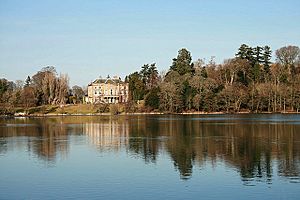John Pringle, Lord Haining facts for kids
John Pringle, Lord Haining (born around 1674 – died August 19, 1754) was an important Scottish lawyer, politician, and judge. He owned a big piece of land near Selkirk. This helped him get a seat in the Parliament of Scotland from 1702 until Scotland and England joined together in 1707. After that, he was a member of the House of Commons of Great Britain until he became a judge in 1729.
Contents
John Pringle's Early Life
John Pringle was the second son of Andrew Pringle. His family lived in the Scottish Borders. John's parents made sure he got a good education. He studied at the University of Edinburgh and then at Utrecht University in the Netherlands. He finished his studies in 1696. In 1698, he became a lawyer, which meant he could argue cases in court.
His Career in Law and Politics
John Pringle quickly became a successful lawyer. Around 1701 or 1702, his father bought him a large estate called The Haining. This land was near the town of Selkirk. Owning this estate gave John a lot of power in the local politics of Selkirkshire.
Thanks to the support of his future father-in-law, Sir James Murray, John Pringle was chosen to be a member of the Parliament of Scotland in 1702. He represented Selkirkshire.
Joining the British Parliament
After Scotland and England officially joined together in 1707, John Pringle was one of 45 Scottish members chosen to be part of the first Parliament of Great Britain. In 1708, he was elected without anyone running against him to the House of Commons of Great Britain. He continued to represent Selkirkshire.
His political success was helped by his strong connection with the Murray family. In 1713, he married Ann Murray, who was Sir James Murray's daughter.
Important Roles and Becoming a Judge
In 1711, John Pringle was given an important job called the joint Keeper of the Signet for Scotland. This job was very valuable. However, he had to give up this job in 1713.
In 1714, John Pringle supported George I of Great Britain becoming the new king. He usually voted with the government in Parliament. He really wanted to become a judge in the highest court in Scotland, the Court of Session.
Finally, in 1729, John Pringle was appointed as a Lord of Session. This meant he became a judge, and he was given the special title Lord Haining.
Later Life and Family
Lord Haining passed away in Edinburgh on August 19, 1754. He was buried in the Old Kirkyard in Selkirk. His wife, Ann, inherited some of his land and received an income from it.
John and Ann Pringle had three sons and three daughters:
- Andrew Pringle (died 1776) became a successful lawyer. He was a top legal officer for Scotland from 1755 to 1759. He also became a judge, known as Lord Alemoor.
- John Pringle (born around 1716 – died 1792) took over the Haining estate from his brother. He also followed his father as a Member of Parliament for Selkirkshire from 1765 to 1786.
- Robert (1719-1775) became a doctor. He lived in Jamaica and later in Philadelphia.
- Ann married Robert Rutherford.
- Helen and Violet never married.


